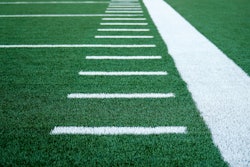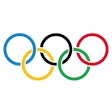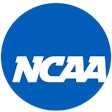
Division I student-athletes continue to graduate at high rates, according to the latest Graduation Success Rate data (PDF) announced Tuesday. The overall single-year rate held steady at 90 percent, which continues to be the highest rate recorded.
"Student-athletes continue to make impressive achievements in the classroom," said Dave Schnase, NCAA vice president of academic and membership affairs. "Student-athletes have demonstrated an incredible commitment to academic success while pursuing their sport at the Division I level. Member schools should be proud for creating meaningful, enriching and educational experiences that help our student-athletes graduate and set a course for long-term success."
Over the course of 20 years, significant gains have been demonstrated within the diverse student-athlete population — Black student-athlete graduation rates increasing by 25 points from 56% to 81%, Hispanic/Latinx student-athletes with a 24-point increase from 64% to 88%, Black FBS football student-athletes with a 27-point increase from 54% to 81%, and Black men's basketball student-athletes with an increase of 35 points from 46% to 81%.
"The data is clear. The exponential graduation success of diverse student populations is truly remarkable," said Felicia Martin, NCAA senior vice president of inclusion education and community engagement. "We applaud the strides our students continue to make in the classroom and acknowledge the steps university and athletic leaders are taking to help achieve equitable academic success for all."
Even when using the federal graduation rate — which does not include students who transfer but is the only national rate collected for comparing athletes to other students — Black male student-athletes are outpacing the general Black male student body by 12 percentage points, and Black female student-athletes are outperforming Black women overall at the same schools by 13 percentage points.
Figures released Tuesday reflect graduation numbers among student-athletes who entered college in 2015. The NCAA has tracked GSR for more than two decades, and student-athletes have long surpassed the original benchmark goal of 80%. Since the GSR's inception, the overall student-athlete rate has soared from 74% to a two-year consistent rate of 90%.
NCAA President Mark Emmert congratulated student-athletes on their continued academic success.
"Proud is an understatement to describe how we feel about the achievements of the talented student-athletes and the members who support them," Emmert said. "They continue to exceed expectations and excel in the classroom to earn their degrees. We celebrate their commitment to academic excellence and admire their dedication to shattering records, both academically and athletically."
Similar patterns of success are occurring throughout the membership at all divisional levels.
Division II academic rates remain high
The NCAA has released the latest Division II graduation rate data (PDF), including the division's Academic Success Rate.
The national four-year ASR average remained at 76%, according to the most recent data. Overall Division II student-athlete graduation rates and many subgroup rates are at or near their highest-ever levels.
"Division II student-athletes achieve great things in the classroom and athletically while also making a difference in their communities," said Terri Steeb Gronau, NCAA vice president of Division II. "Division II schools and conferences are committed to the division's Life in the Balance philosophy, which allows their student-athletes to reach their highest potential athletically, academically and on their campuses and in their communities."
The NCAA developed the Division II ASR at the request of college and university presidents who believed the federal graduation rate was flawed. Division II's ASR data includes student-athletes who transfer into a school and removes student-athletes who left the school in good academic standing. In addition, given the partial-scholarship financial aid model of Division II, the ASR data includes student-athletes not on athletically related financial aid. The result is that ASR captures more than 30,000 nonscholarship student-athletes who were enrolled in the four years covered in the most recent data.
Even when using the less-inclusive federal rate, Division II student-athletes outperform the general student body by 8 percentage points. The federal rates for Division II student-athletes and the student body both held steady, with the student-athlete rate at 60% and the general student body at 52%.
Notable single-class student-athlete increases in ASR over the 16 years of calculating this rate in Division II include overall (from 69% to 77%), Black women (from 61% to 79%), Hispanic/Latinx men (48% to 67%) and Hispanic/Latinx women (63% to 78%).
In addition, there has been a notable increase in ASR for two-year transfer student-athletes over the past 10 years (from 57% to 74%).
At the NCAA Convention in January 2014, the Division II membership approved a legislative package intended to increase student-athlete success and graduation rates. The package addresses a variety of academic standards, and includes adjustments to eligibility standards, progress-toward-degree requirements and standards for transfers from two-year colleges. This is the fourth academic year in which all of these requirements are in effect.
Division III student-athletes continue academic success
The 2021 reporting cycle was the third year the federal graduation rate and Academic Success Rate data (PDF) submission was required for all Division III schools.
The national four-class average ASR for Division III remained at 88%, according to the most recent ASR data. The women's rate stayed at 94%, while the men's rate increased 1 percentage point to 84%.
For men, the sports with the highest ASRs for 2022 were skiing (94%) and water polo (92%). For women, the sports with the highest ASRs for 2022 also were skiing (98%) and water polo (97%). All women's sports were over 90%.
Like Division I's Graduation Success Rate and Division II's ASR, Division III's ASR includes transfers in the calculation and accounts for students who left school while academically eligible. Division III is now in its 13th year of collecting student-athlete graduation rates.
When using the federal graduation rate, the only common measure collected for comparing athletes and nonathletes, Division III student-athletes outperform their peers in the general student body. The four-class average federal rate for student-athletes was 70%, and the federal rate for the overall student body was 67%.
"This year's graduation report supports our Division III institutions' commitment to achieving academic excellence within a competitive athletics experience," said Louise McCleary, vice president of Division III. "I want to thank all of the Division III student-athletes for their hard work and the institutions for creating a space for student-athletes to thrive in the classroom, in competition and in the community."
At the 2019 NCAA Convention, the Division III membership passed a proposal requiring all schools to submit student-athlete graduation rate data to the NCAA on an annual basis.




































